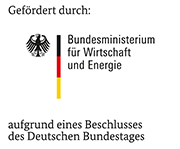16125 N

Chromium diffusion coating on ferritic-martensitic steel
| Laufzeit: | 01.07.2009 - 30.06.2011 |
|---|---|
| Geldgeber: | Bundesministerium für Wirtschaft und Technologie über AiF |
| Bearbeiter: | Diana Schmidt |
| Arbeitsgruppe: | Hochtemperaturwerkstoffe |
The main aim of modern power plant technology is an increase in efficiency. The best means to raise efficiency are steam parameters such as pressure (around 300 bar) and temperature (650°C or higher). This leads to extreme demands on the superheater components.
Suitable materials are austenitic steels and nickel base alloys. Ferritic-martensitic steels are becoming more interesting because of their better heat transfer behaviour and a lower coefficient of thermal expansion, as well as lower costs. Under these conditions the 9-12% Cr steels have sufficient creep strength however their corrosion behaviour needs to be improved. The oxidation resistance in water vapour containing combustion atmospheres (up to 25% in the combustion of biomass or the oxyfuel process) is not yet satisfactory.
Protection against corrosion results through the formation of a slow growing Cr-rich oxide scale. The required chromium diffuses along the grain boundaries of the steel and results in chromium depletion in the metal subsurface.
In water vapour containing combustion environments the poor corrosion behaviour can be explained because of the formation of volatile chromium species such as CrO2 (OH)2 . This leads to further depletion of chromium in the metal subsurface. This reduces the formation of Cr-rich protective oxide scales and oxidation resistance changes from protective to non-protective behaviour. Fast growing iron rich oxides are then formed.
The formation of volatile chromium species in water vapour environments can be suppressed by the addition of manganese. The MnCr spinels that form have a higher resistance against evaporation than Cr oxide in water vapour environments. The addition of manganese must not alter the bulk phase. This can be achieved by using different diffusion processes, such as pack cementation or heat treatment after deposition of pure manganese on the surface, e.g. by sputtering. These aspects are investigated in the current project.

Das IGF-Vorhaben Nr. 16125 N der Forschungsvereinigung DECHEMA e.V., Theodor-Heuss-Allee 25, 60486 Frankfurt am Main wurde über die AiF im Rahmen des Programms zur Förderung der industriellen Gemeinschaftsforschung (IGF) vom Bundesministerium für Wirtschaft und Energie aufgrund eines Beschlusses des Deutschen Bundestages gefördert.
PD Dr. Mathias Galetz
Tel.: 069 / 7564-397
E-Mail: mathias.galetz
D. Schmidt, M. Schütze, Materials Science Forum 696 (2011), 330
Abschlussbericht (pdf, 10 MB)